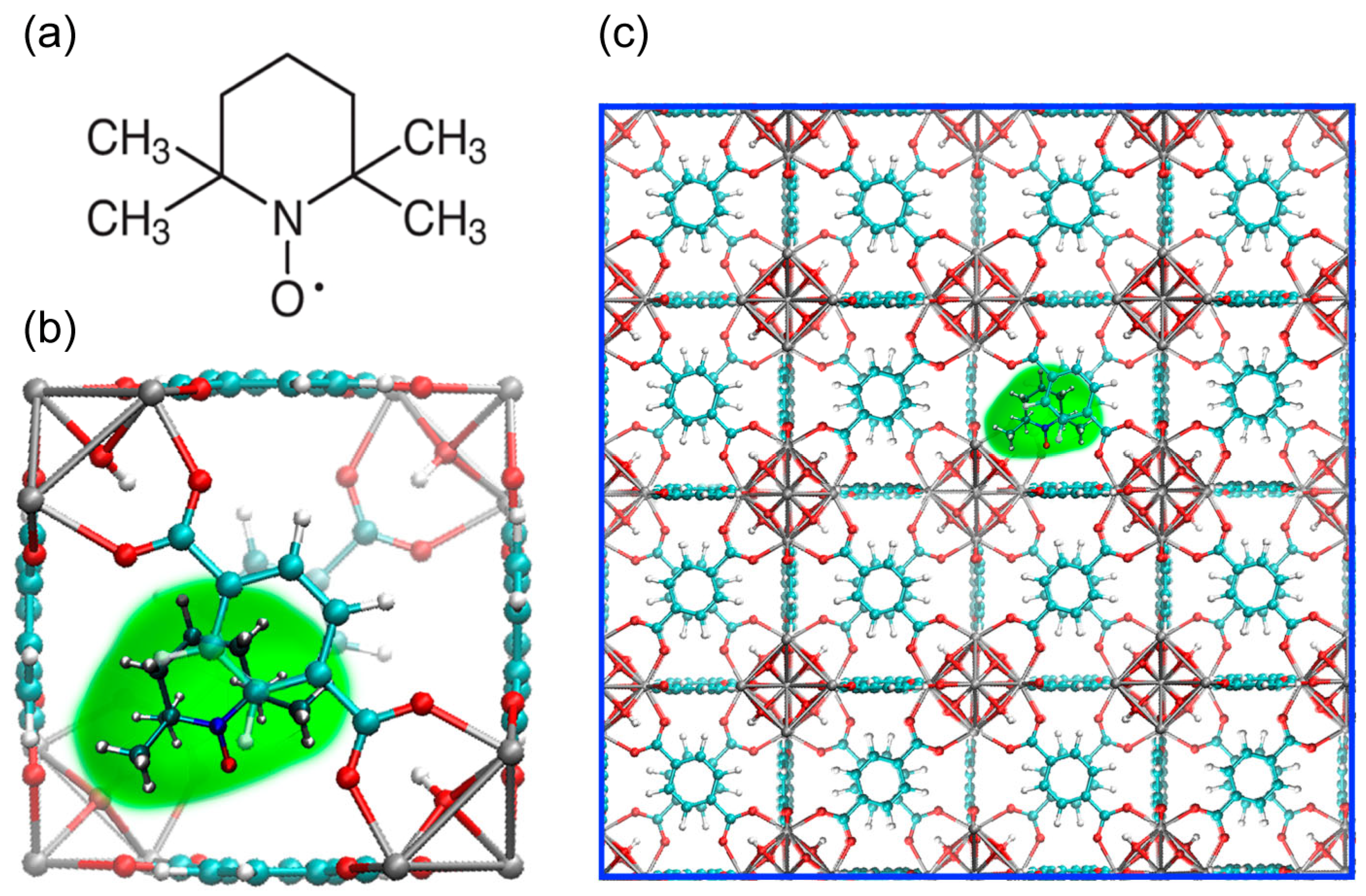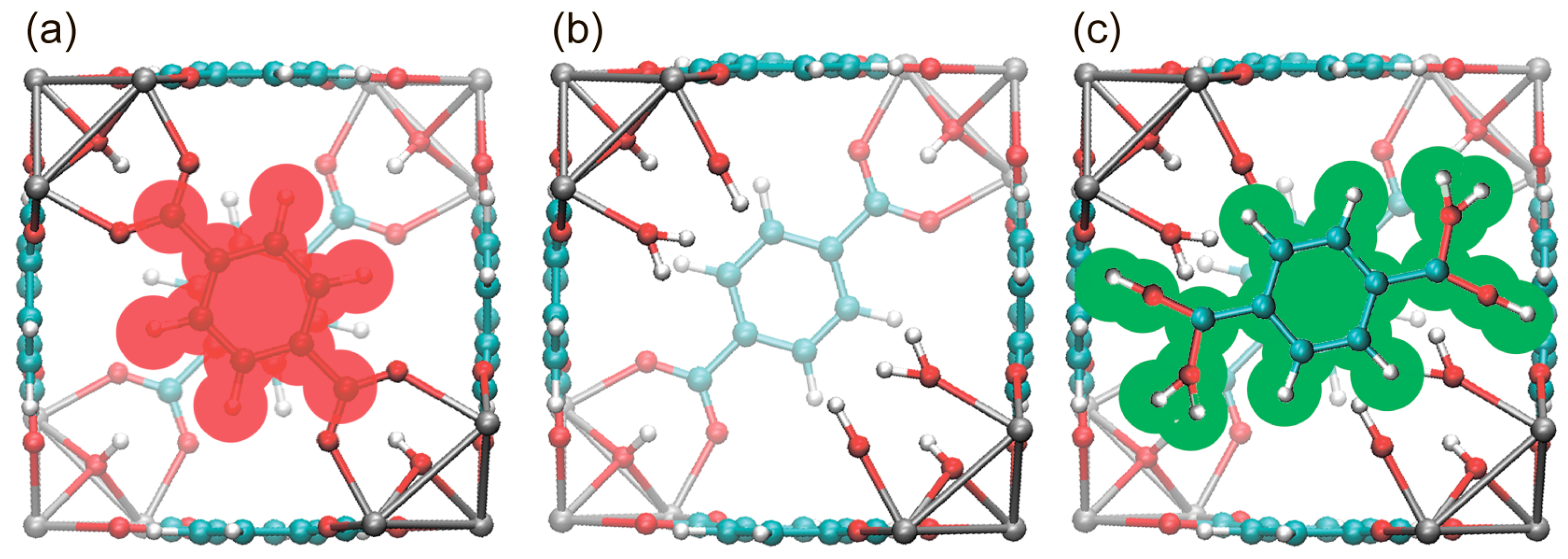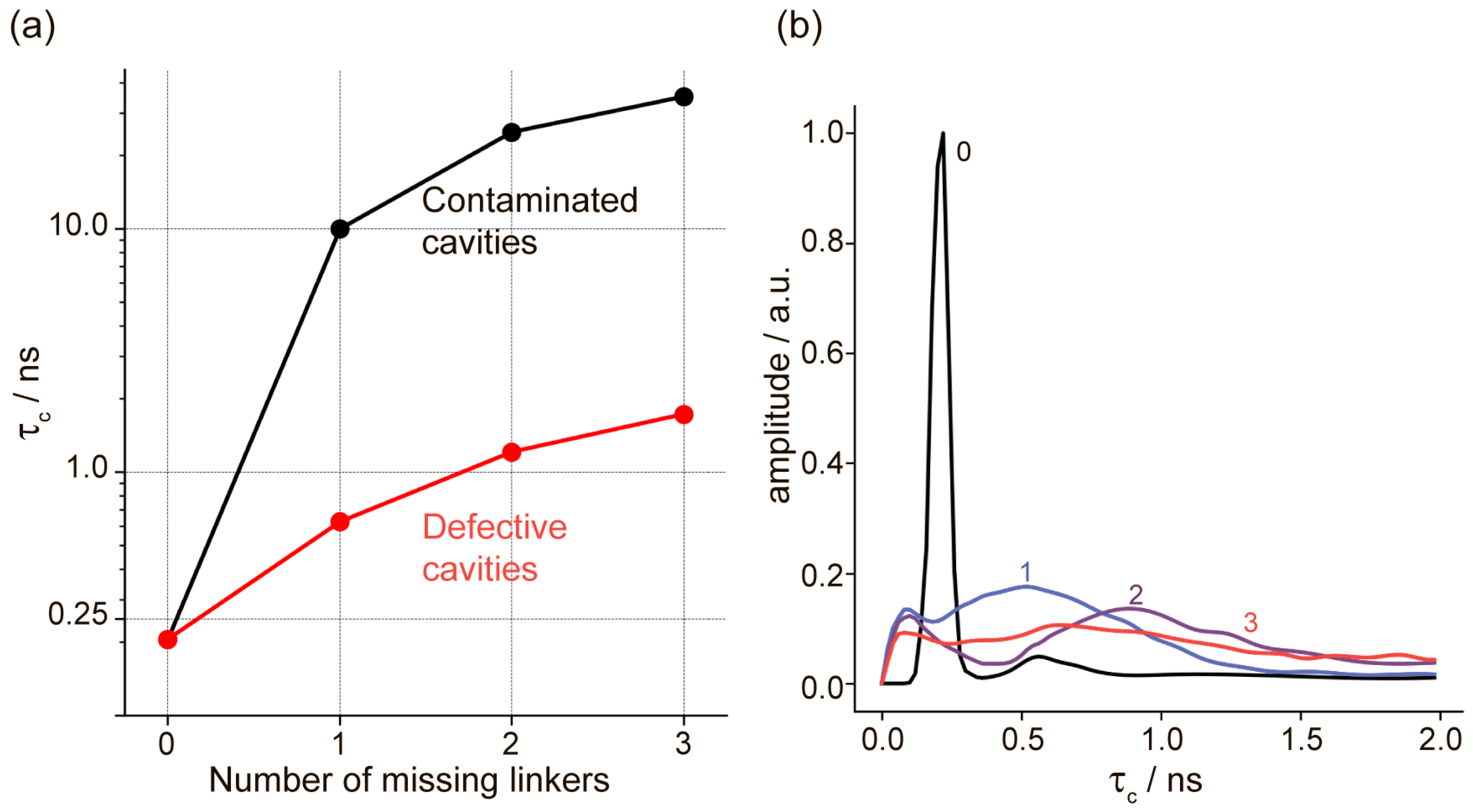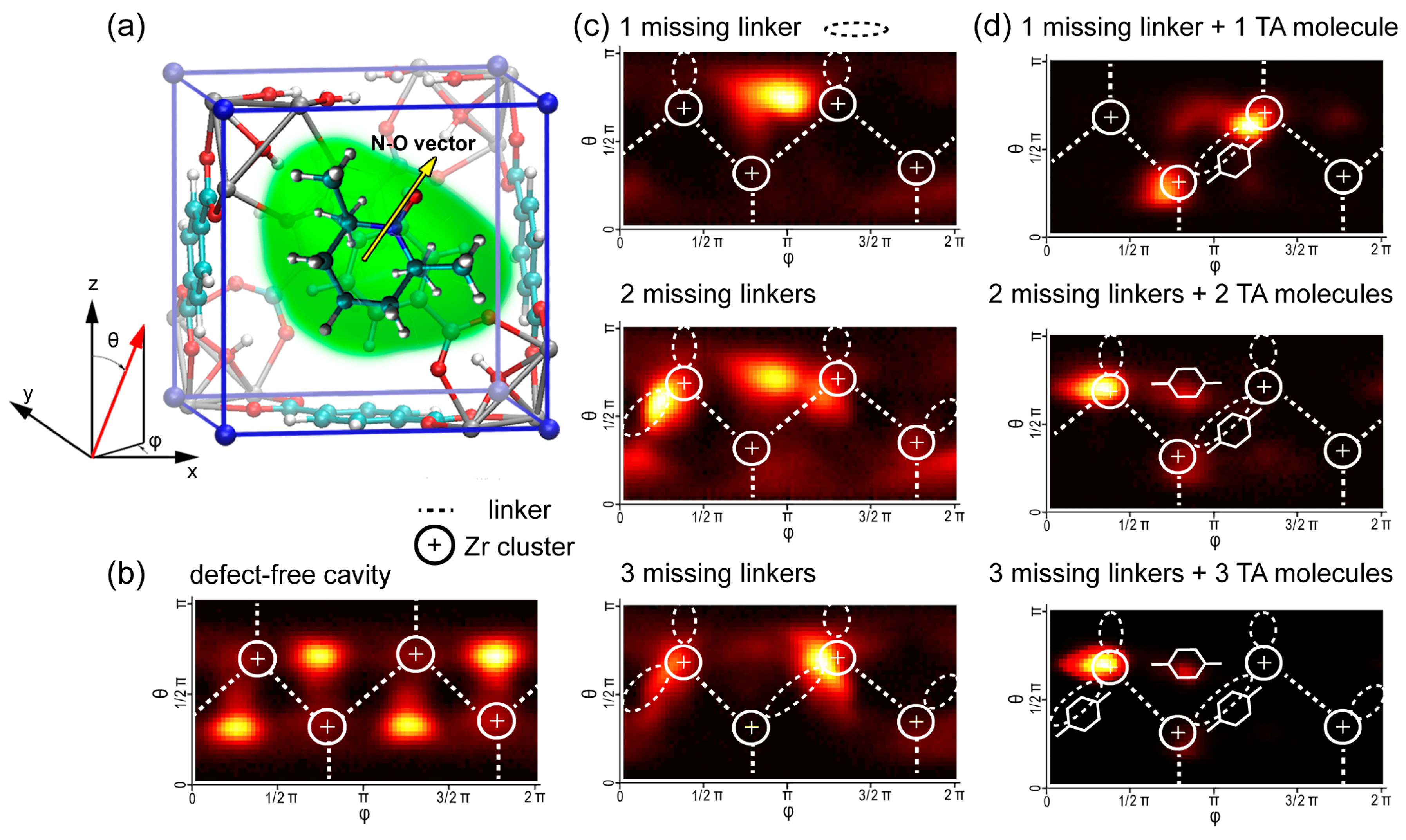Pressure Sensitivity of UiO-66 Framework with Encapsulated Spin Probe: A Molecular Dynamics Study
Abstract
1. Introduction
2. Results and Discussion
3. Methods
4. Conclusions
Supplementary Materials
Author Contributions
Funding
Institutional Review Board Statement
Informed Consent Statement
Data Availability Statement
Conflicts of Interest
References
- Göstl, R.; Sijbesma, R.P. π-Extended Anthracenes as Sensitive Probes for Mechanical Stress. Chem. Sci. 2016, 7, 370–375. [Google Scholar] [CrossRef] [PubMed]
- Roberts, D.R.T.; Holder, S.J. Mechanochromic Systems for the Detection of Stress, Strain and Deformation in Polymeric Materials. J. Mater. Chem. 2011, 21, 8256–8268. [Google Scholar] [CrossRef]
- Chen, Y.; Mellot, G.; Van Luijk, D.; Creton, C.; Sijbesma, R.P. Mechanochemical Tools for Polymer Materials. Chem. Soc. Rev. 2021, 50, 4100–4140. [Google Scholar] [CrossRef]
- Maryunina, K.Y.; Zhang, X.; Nishihara, S.; Inoue, K.; Morozov, V.A.; Romanenko, G.V.; Ovcharenko, V.I. A Heterospin Pressure Sensor. J. Mater. Chem. C 2015, 3, 7788–7791. [Google Scholar] [CrossRef]
- Artiukhova, N.A.; Romanenko, G.V.; Bogomyakov, A.S.; Barskaya, I.Y.; Veber, S.L.; Fedin, M.V.; Maryunina, K.Y.; Inoue, K.; Ovcharenko, V.I. Cu(II) Complex with Nitronyl Nitroxide Whose Paramagnetism Is Suppressed by Temperature Decrease and/or Pressure Increase. J. Mater. Chem. C 2016, 4, 11157–11163. [Google Scholar] [CrossRef]
- Deneke, N.; Rencheck, M.L.; Davis, C.S. An Engineer’s Introduction to Mechanophores. Soft Matter 2020, 16, 6230–6252. [Google Scholar] [CrossRef]
- Chen, Y.; Spiering, A.J.H.; Karthikeyan, S.; Peters, G.W.M.; Meijer, E.W.; Sijbesma, R.P. Mechanically Induced Chemiluminescence from Polymers Incorporating a 1,2-Dioxetane Unit in the Main Chain. Nat. Chem. 2012, 4, 559–562. [Google Scholar] [CrossRef]
- Chen, Y.; Sijbesma, R.P. Dioxetanes as Mechanoluminescent Probes in Thermoplastic Elastomers. Macromolecules 2014, 47, 3797–3805. [Google Scholar] [CrossRef]
- Imato, K.; Irie, A.; Kosuge, T.; Ohishi, T.; Nishihara, M.; Takahara, A.; Otsuka, H. Mechanophores with a Reversible Radical System and Freezing-Induced Mechanochemistry in Polymer Solutions and Gels. Angew. Chemie Int. Ed. 2015, 54, 6168–6172. [Google Scholar] [CrossRef]
- Kalaj, M.; Bentz, K.C.; Ayala, S.; Palomba, J.M.; Barcus, K.S.; Katayama, Y.; Cohen, S.M. MOF-Polymer Hybrid Materials: From Simple Composites to Tailored Architectures. Chem. Rev. 2020, 120, 8267–8302. [Google Scholar] [CrossRef]
- Sapchenko, S.A.; Barsukova, M.O.; Belosludov, R.V.; Kovalenko, K.A.; Samsonenko, D.G.; Poryvaev, A.S.; Sheveleva, A.M.; Fedin, M.V.; Bogomyakov, A.S.; Dybtsev, D.N.; et al. Understanding Hysteresis in Carbon Dioxide Sorption in Porous Metal-Organic Frameworks. Inorg. Chem. 2019, 58, 6811–6820. [Google Scholar] [CrossRef] [PubMed]
- Poryvaev, A.S.; Sheveleva, A.M.; Demakov, P.A.; Arzumanov, S.S.; Stepanov, A.G.; Dybtsev, D.N.; Fedin, M.V. Pulse EPR Study of Gas Adsorption in Cu2+-Doped Metal–Organic Framework [Zn2(1,4-Bdc)2(Dabco)]. Appl. Magn. Reson. 2018, 49, 255–264. [Google Scholar] [CrossRef]
- Ivanov, M.Y.; Poryvaev, A.S.; Polyukhov, D.M.; Prikhod’ko, S.A.; Adonin, N.Y.; Fedin, M.V. Nanoconfinement Effects on Structural Anomalies in Imidazolium Ionic Liquids. Nanoscale 2020, 12, 23480–23487. [Google Scholar] [CrossRef] [PubMed]
- Poryvaev, A.S.; Yazikova, A.A.; Polyukhov, D.M.; Fedin, M.V. Ultrahigh Selectivity of Benzene/Cyclohexane Separation by ZIF-8 Framework: Insights from Spin-Probe EPR Spectroscopy. Microporous Mesoporous Mater. 2022, 330, 111564. [Google Scholar] [CrossRef]
- Abylgazina, L.; Senkovska, I.; Maliuta, M.; Bachetzky, C.; Rauche, M.; Pöschel, K.; Schmidt, J.; Isaacs, M.; Morgan, D.; Otyepka, M.; et al. The Role of Surface Deformation on Responsivity of the Pillared Layer Metal-Organic Framework DUT-8(Ni). Chem. Sci. 2025, 16, 6402–6417. [Google Scholar] [CrossRef]
- Thangavel, K.; Folli, A.; Fischer, M.; Hartmann, M.; Murphy, D.M.; Pöppl, A. Utilizing EPR Spectroscopy to Investigate the Liquid Adsorption Properties of Bimetallic MIL-53(Al/Cr) MOF. RSC Adv. 2024, 14, 4244–4251. [Google Scholar] [CrossRef]
- Fernadi Lukman, M.; Chetry, S.; Sarkar, P.; Bon, V.; Thangavel, K.; Kaskel, S.; Hirscher, M.; Krautscheid, H.; Pöppl, A. In Situ Electron Paramagnetic Resonance Investigation of Isotope-Selective Breathing in MIL-53 During Dihydrogen Adsorption. Chem. A Eur. J. 2025, 31, e202500088. [Google Scholar] [CrossRef]
- Polyukhov, D.M.; Krause, S.; Bon, V.; Poryvaev, A.S.; Kaskel, S.; Fedin, M.V. Structural Transitions of the Metal-Organic Framework DUT-49(Cu) upon Physi- A Nd Chemisorption Studied by in Situ Electron Paramagnetic Resonance Spectroscopy. J. Phys. Chem. Lett. 2020, 11, 5856–5862. [Google Scholar] [CrossRef]
- Efremov, A.A.; Poryvaev, A.S.; Polyukhov, D.M.; Sagdeev, R.Z.; Fedin, M.V. Anisotropic Rotation of TEMPO Radical in the Cavities of Metal–Organic Framework ZIF-8 Induced by Guest Solvents. Appl. Magn. Reson. 2023, 54, 93–105. [Google Scholar] [CrossRef]
- Winarta, J.; Shan, B.; McIntyre, S.M.; Ye, L.; Wang, C.; Liu, J.; Mu, B. A Decade of UiO-66 Research: A Historic Review of Dynamic Structure, Synthesis Mechanisms, and Characterization Techniques of an Archetypal Metal-Organic Framework. Cryst. Growth Des. 2020, 20, 1347–1362. [Google Scholar] [CrossRef]
- Valenzano, L.; Civalleri, B.; Chavan, S.; Bordiga, S.; Nilsen, M.H.; Jakobsen, S.; Lillerud, K.P.; Lamberti, C. Disclosing the Complex Structure of UiO-66 Metal Organic Framework: A Synergic Combination of Experiment and Theory. Chem. Mater. 2011, 23, 1700–1718. [Google Scholar] [CrossRef]
- Kandiah, M.; Nilsen, M.H.; Usseglio, S.; Jakobsen, S.; Olsbye, U.; Tilset, M.; Larabi, C.; Quadrelli, E.A.; Bonino, F.; Lillerud, K.P. Synthesis and Stability of Tagged UiO-66 Zr-MOFs. Chem. Mater. 2010, 22, 6632–6640. [Google Scholar] [CrossRef]
- Rueda-Navarro, C.M.; Abou Khalil, Z.; Melillo, A.; Ferrer, B.; Montero, R.; Longarte, A.; Daturi, M.; Vayá, I.; El-Roz, M.; Martínez-Martínez, V.; et al. Solar Gas-Phase CO2 Hydrogenation by Multifunctional UiO-66 Photocatalysts. ACS Catal. 2024, 14, 6470–6487. [Google Scholar] [CrossRef]
- Usman, J.; Abba, S.I.; Baig, N.; Abu-Zahra, N.; Hasan, S.W.; Aljundi, I.H. Design and Machine Learning Prediction of In Situ Grown PDA-Stabilized MOF (UiO-66-NH2) Membrane for Low-Pressure Separation of Emulsified Oily Wastewater. ACS Appl. Mater. Interfaces 2024, 16, 16271–16289. [Google Scholar] [CrossRef]
- Vo, T.K.; Kim, J.; Park, J.; Dao, D.Q.; Truong, H.B. Aminobenzoate-Defected UiO-66(Zr)–NH2 Frameworks: Scalable Synthesis and Characterizations for Adsorptive Denitrogenation from Model Fuel. Chem. Eng. J. 2024, 481, 148570. [Google Scholar] [CrossRef]
- Ilić, N.; Tan, K.; Mayr, F.; Hou, S.; Aumeier, B.M.; Morales, E.M.C.; Hübner, U.; Cookman, J.; Schneemann, A.; Gagliardi, A.; et al. Trace Adsorptive Removal of PFAS from Water by Optimizing the UiO-66 MOF Interface. Adv. Mater. 2024, 37, 2413120. [Google Scholar] [CrossRef]
- Wu, H.; Yildirim, T.; Zhou, W. Exceptional Mechanical Stability of Highly Porous Zirconium Metal-Organic Framework UiO-66 and Its Important Implications. J. Phys. Chem. Lett. 2013, 4, 925–930. [Google Scholar] [CrossRef]
- Wu, H.; Chua, Y.S.; Krungleviciute, V.; Tyagi, M.; Chen, P.; Yildirim, T.; Zhou, W. Unusual and Highly Tunable Missing-Linker Defects in Zirconium Metal-Organic Framework UiO-66 and Their Important Effects on Gas Adsorption. J. Am. Chem. Soc. 2013, 135, 10525–10532. [Google Scholar] [CrossRef]
- DeStefano, M.R.; Islamoglu, T.; Garibay, S.J.; Hupp, J.T.; Farha, O.K. Room-Temperature Synthesis of UiO-66 and Thermal Modulation of Densities of Defect Sites. Chem. Mater. 2017, 29, 1357–1361. [Google Scholar] [CrossRef]
- Cmarik, G.E.; Kim, M.; Cohen, S.M.; Walton, K.S. Tuning the Adsorption Properties of Uio-66 via Ligand Functionalization. Langmuir 2012, 28, 15606–15613. [Google Scholar] [CrossRef]
- Vermoortele, F.; Bueken, B.; Le Bars, G.; Van De Voorde, B.; Vandichel, M.; Houthoofd, K.; Vimont, A.; Daturi, M.; Waroquier, M.; Van Speybroeck, V.; et al. Synthesis Modulation as a Tool to Increase the Catalytic Activity of Metal-Organic Frameworks: The Unique Case of UiO-66(Zr). J. Am. Chem. Soc. 2013, 135, 11465–11468. [Google Scholar] [CrossRef] [PubMed]
- Poryvaev, A.S.; Larionov, K.P.; Albrekht, Y.N.; Efremov, A.A.; Kiryutin, A.S.; Smirnova, K.A.; Evtushok, V.Y.; Fedin, M.V. UiO-66 Framework with an Encapsulated Spin Probe: Synthesis and Exceptional Sensitivity to Mechanical Pressure. Phys. Chem. Chem. Phys. 2023, 25, 13846–13853. [Google Scholar] [CrossRef] [PubMed]
- Rogge, S.M.J.; Yot, P.G.; Jacobsen, J.; Muniz-Miranda, F.; Vandenbrande, S.; Gosch, J.; Ortiz, V.; Collings, I.E.; Devautour-Vinot, S.; Maurin, G.; et al. Charting the Metal-Dependent High-Pressure Stability of Bimetallic UiO-66 Materials. ACS Mater. Lett. 2020, 2, 438–445. [Google Scholar] [CrossRef] [PubMed]
- Rogge, S.M.J.; Wieme, J.; Vanduyfhuys, L.; Vandenbrande, S.; Maurin, G.; Verstraelen, T.; Waroquier, M.; Van Speybroeck, V. Thermodynamic Insight in the High-Pressure Behavior of UiO-66: Effect of Linker Defects and Linker Expansion. Chem. Mater. 2016, 28, 5721–5732. [Google Scholar] [CrossRef]
- Spitsyna, A.S.; Poryvaev, A.S.; Sannikova, N.E.; Yazikova, A.A.; Kirilyuk, I.A.; Dobrynin, S.A.; Chinak, O.A.; Fedin, M.V.; Krumkacheva, O.A. Stability of ZIF-8 Nanoparticles in Most Common Cell Culture Media. Molecules 2022, 27, 3240. [Google Scholar] [CrossRef]
- Poryvaev, A.S.; Yazikova, A.A.; Polyukhov, D.M.; Chinak, O.A.; Richter, V.A.; Krumkacheva, O.A.; Fedin, M.V. Guest Leakage from ZIF-8 Particles under Drug Delivery Conditions: Quantitative Characterization and Guest-Induced Framework Stabilization. J. Phys. Chem. C 2021, 125, 15606–15613. [Google Scholar] [CrossRef]
- Poryvaev, A.S.; Polyukhov, D.M.; Fedin, M.V. Mitigation of Pressure-Induced Amorphization in Metal-Organic Framework ZIF-8 upon EPR Control. ACS Appl. Mater. Interfaces 2020, 12, 16655–16661. [Google Scholar] [CrossRef]
- Sun, Y. UiO-66 Metal-Organic Framework Membranes: Structural Engineering for Separation Applications. Membranes 2025, 15, 8. [Google Scholar] [CrossRef]
- Dissegna, S.; Vervoorts, P.; Hobday, C.L.; Düren, T.; Daisenberger, D.; Smith, A.J.; Fischer, R.A.; Kieslich, G. Tuning the Mechanical Response of Metal-Organic Frameworks by Defect Engineering. J. Am. Chem. Soc. 2018, 140, 11581–11584. [Google Scholar] [CrossRef]
- Monteagudo-Olivan, R.; Paseta, L.; Potier, G.; López-Ram-de-Viu, P.; Coronas, J. Solvent-Free Encapsulation at High Pressure with Carboxylate-Based MOFs. Eur. J. Inorg. Chem. 2019, 2019, 29–36. [Google Scholar] [CrossRef]
- Trickett, C.A.; Gagnon, K.J.; Lee, S.; Gándara, F.; Bürgi, H.B.; Yaghi, O.M. Definitive Molecular Level Characterization of Defects in UiO-66 Crystals. Angew. Chemie Int. Ed. 2015, 54, 11162–11167. [Google Scholar] [CrossRef] [PubMed]
- Islamov, M.; Boone, P.; Babaei, H.; McGaughey, A.J.H.; Wilmer, C.E. Correlated Missing Linker Defects Increase Thermal Conductivity in Metal–Organic Framework UiO-66. Chem. Sci. 2023, 14, 6592–6600. [Google Scholar] [CrossRef]
- De Vos, A.; Hendrickx, K.; Van Der Voort, P.; Van Speybroeck, V.; Lejaeghere, K. Missing Linkers: An Alternative Pathway to UiO-66 Electronic Structure Engineering. Chem. Mater. 2017, 29, 3006–3019. [Google Scholar] [CrossRef]
- Feng, Y.; Chen, Q.; Jiang, M.; Yao, J. Tailoring the Properties of UiO-66 through Defect Engineering: A Review. Ind. Eng. Chem. Res. 2019, 58, 17646–17659. [Google Scholar] [CrossRef]
- McBeck, J.; Ben-Zion, Y.; Renard, F. Fracture Network Localization Preceding Catastrophic Failure in Triaxial Compression Experiments on Rocks. Front. Earth Sci. 2021, 9, 778811. [Google Scholar] [CrossRef]
- Bordignon, E. EPR Spectroscopy of Nitroxide Spin Probes. eMagRes 2017, 6, 235–254. [Google Scholar] [CrossRef]
- Yang, Q.; Jobic, H.; Salles, F.; Kolokolov, D.; Guillerm, V.; Serre, C.; Maurin, G. Probing the Dynamics of CO2 and CH4 within the Porous Zirconium Terephthalate UiO-66(Zr): A Synergic Combination of Neutron Scattering Measurements and Molecular Simulations. Chem. A Eur. J. 2011, 17, 8882–8889. [Google Scholar] [CrossRef]
- Stendardo, E.; Pedone, A.; Cimino, P.; Cristina Menziani, M.; Crescenzi, O.; Barone, V. Extension of the AMBER Force-Field for the Study of Large Nitroxides in Condensed Phases: An Ab Initio Parameterization. Phys. Chem. Chem. Phys. 2010, 12, 11191–11196. [Google Scholar] [CrossRef]
- Sheveleva, A.M.; Anikeenko, A.V.; Poryvaev, A.S.; Kuzmina, D.L.; Shundrina, I.K.; Kolokolov, D.I.; Stepanov, A.G.; Fedin, M.V. Probing Gas Adsorption in Metal-Organic Framework ZIF-8 by EPR of Embedded Nitroxides. J. Phys. Chem. C 2017, 121, 19880–19886. [Google Scholar] [CrossRef]
- McGibbon, R.T.; Beauchamp, K.A.; Harrigan, M.P.; Klein, C.; Swails, J.M.; Hernández, C.X.; Schwantes, C.R.; Wang, L.P.; Lane, T.J.; Pande, V.S. MDTraj: A Modern Open Library for the Analysis of Molecular Dynamics Trajectories. Biophys. J. 2015, 109, 1528–1532. [Google Scholar] [CrossRef]
- Humphrey, W.; Dalke, A.; Schulten, K. VMD: Visual Molecular Dynamics. J. Mol. Graph. 1996, 14, 33–38. [Google Scholar] [CrossRef] [PubMed]
- Avogadro—Free Cross-Platform Molecular Editor—Avogadro. Available online: https://avogadro.cc/ (accessed on 14 April 2025).
- Hanwell, M.D.; Curtis, D.E.; Lonie, D.C.; Vandermeerschd, T.; Zurek, E.; Hutchison, G.R. Avogadro: An Advanced Semantic Chemical Editor, Visualization, and Analysis Platform. J. Cheminform. 2012, 4, 1–17. [Google Scholar] [CrossRef] [PubMed]
- Harris, C.R.; Millman, K.J.; van der Walt, S.J.; Gommers, R.; Virtanen, P.; Cournapeau, D.; Wieser, E.; Taylor, J.; Berg, S.; Smith, N.J.; et al. Array Programming with NumPy. Nature 2020, 585, 357–362. [Google Scholar] [CrossRef] [PubMed]
- Polyukhov, D.M.; Poryvaev, A.S.; Gromilov, S.A.; Fedin, M.V. Precise Measurement and Controlled Tuning of Effective Window Sizes in ZIF-8 Framework for Efficient Separation of Xylenes. Nano Lett. 2019, 19, 6506–6510. [Google Scholar] [CrossRef]
- Polyukhov, D.M.; Poryvaev, A.S.; Sukhikh, A.S.; Gromilov, S.A.; Fedin, M.V. Fine-Tuning Window Apertures in ZIF-8/67 Frameworks by Metal Ions and Temperature for High-Efficiency Molecular Sieving of Xylenes. ACS Appl. Mater. Interfaces 2021, 13, 40830–40836. [Google Scholar] [CrossRef]
- Available online: https://traken.chem.yale.edu/ligpargen/ (accessed on 14 April 2025).
- Available online: https://m3g.github.io/packmol/ (accessed on 14 April 2025).
- Stoll, S.; Schweiger, A. EasySpin, a comprehensive software package for spectral simulation and analysis in EPR. J. Magn. Reson. 2006, 178, 42–55. [Google Scholar] [CrossRef]





| Number of Missing Linkers | Defective Cavity | Contaminated Cavity |
|---|---|---|
| τc/ns | τc/ns | |
| 0 | 0.2 | 0.2 |
| 1 | 0.6 | ~10 |
| 2 | 1.2 | ~27 |
| 3 | 1.7 | ~41 |
| Sample | Mobile Fraction | Immobile Fraction | ||
|---|---|---|---|---|
| τc/ns | Fraction | τc/ns | Fraction | |
| Initial, 0 GPa | 1.0 | 100% | - | 0% |
| After, 0.06 GPa | 2.2 | 90% | >100 | 10% |
| After, 0.13 GPa | 3.2 | 49% | >100 | 51% |
Disclaimer/Publisher’s Note: The statements, opinions and data contained in all publications are solely those of the individual author(s) and contributor(s) and not of MDPI and/or the editor(s). MDPI and/or the editor(s) disclaim responsibility for any injury to people or property resulting from any ideas, methods, instructions or products referred to in the content. |
© 2025 by the authors. Licensee MDPI, Basel, Switzerland. This article is an open access article distributed under the terms and conditions of the Creative Commons Attribution (CC BY) license (https://creativecommons.org/licenses/by/4.0/).
Share and Cite
Alimov, D.V.; Poryvaev, A.S.; Fedin, M.V. Pressure Sensitivity of UiO-66 Framework with Encapsulated Spin Probe: A Molecular Dynamics Study. Molecules 2025, 30, 2247. https://doi.org/10.3390/molecules30102247
Alimov DV, Poryvaev AS, Fedin MV. Pressure Sensitivity of UiO-66 Framework with Encapsulated Spin Probe: A Molecular Dynamics Study. Molecules. 2025; 30(10):2247. https://doi.org/10.3390/molecules30102247
Chicago/Turabian StyleAlimov, Dmitry V., Artem S. Poryvaev, and Matvey V. Fedin. 2025. "Pressure Sensitivity of UiO-66 Framework with Encapsulated Spin Probe: A Molecular Dynamics Study" Molecules 30, no. 10: 2247. https://doi.org/10.3390/molecules30102247
APA StyleAlimov, D. V., Poryvaev, A. S., & Fedin, M. V. (2025). Pressure Sensitivity of UiO-66 Framework with Encapsulated Spin Probe: A Molecular Dynamics Study. Molecules, 30(10), 2247. https://doi.org/10.3390/molecules30102247







